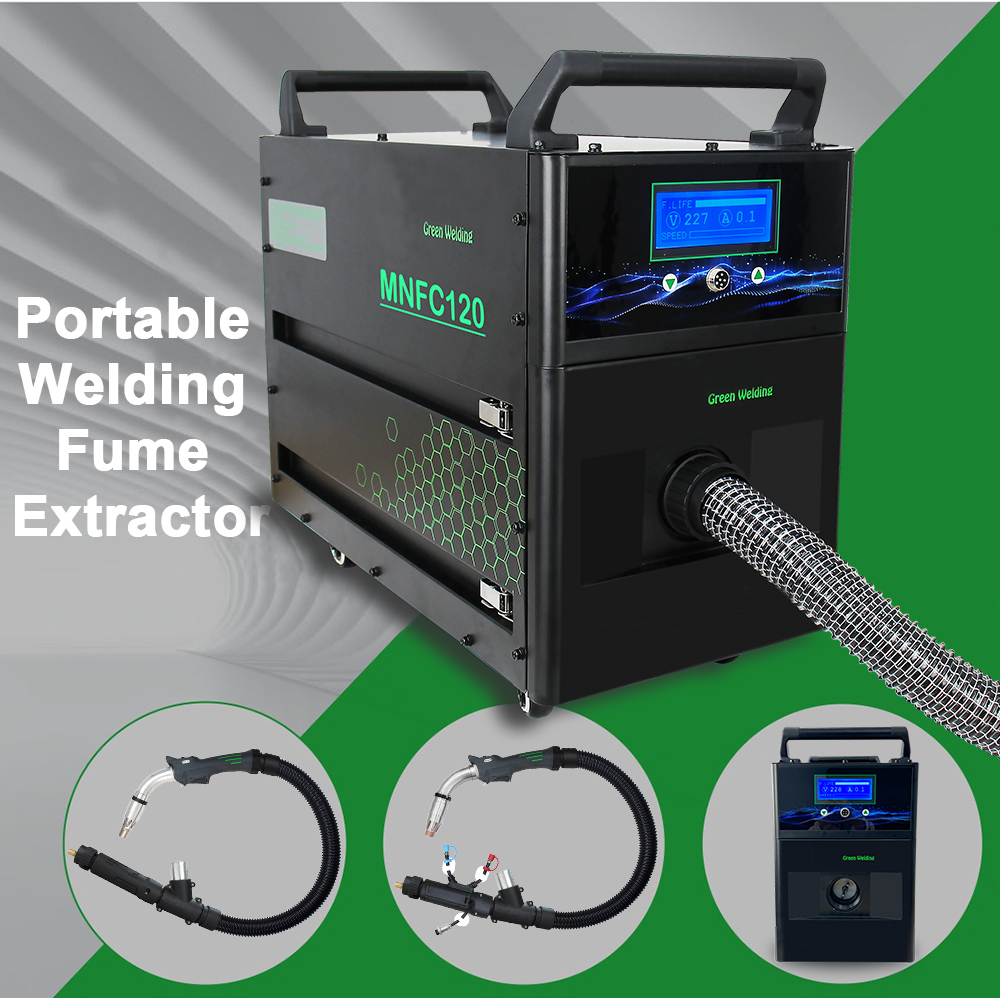In the dynamic world of industrial fabrication and construction, welding stands as a cornerstone process. However, with the essential work of welding comes the generation of welding fumes, which pose significant health risks and environmental challenges. Effectively extracting these fumes is not just a matter of compliance with safety regulations; it is a critical step in protecting workers’ well - being and maintaining efficient, sustainable operations. This in - depth blog aims to shed light on the multifaceted approach to welding fume extraction, offering valuable insights for businesses and professionals navigating this crucial aspect of their work environments.
Understanding Welding Fumes and Their Hazards
Welding fumes are complex mixtures of various airborne contaminants produced during the welding process. They consist of fine particles of metal oxides, including but not limited to iron oxide, manganese oxide, chromiumVI () compounds, and other potentially harmful substances, depending on the materials being welded and the type of welding process employed. Additionally, welding can release harmful gases such as ozone, nitrogen oxides, and carbon monoxide.
Prolonged exposure to welding fumes has been linked to a range of severe health issues. Respiratory problems are among the most common concerns, with workers potentially developing conditions like asthma, bronchitis, and even more debilitating lung diseases. There is also a significant risk of cardiovascular issues, as some fume components can affect heart function. Furthermore, certain metal fumes, such as those containing chromium (VI), are known carcinogens, posing long - term cancer risks for those frequently exposed. Neurological damage is another grave hazard, particularly from manganese - rich fumes, which can lead to symptoms akin to Parkinson’s disease.
The Fundamentals of Welding Fume Extraction
Source Capture vs. Overall Ventilation
The journey of effective welding fume extraction begins with understanding the two primary strategies: source capture and overall ventilation. Source capture involves intercepting the fumes right at their point of origin, which is typically the welding arc. This method is highly efficient as it prevents fumes from dispersing into the general workspace. It can be achieved through various means such as fume extraction guns, which are integrated into the welding process itself, allowing for simultaneous welding and fume extraction. Alternatively, local exhaust ventilation (LEV) systems with flexible arms or hoods positioned close to the welding area can also serve this purpose.
Overall ventilation, on the other hand, aims to dilute and remove fumes from the entire workshop or designated work area. This is often accomplished through a combination of supply and exhaust ventilation systems. While it may not be as targeted as source capture, it plays a vital role in maintaining acceptable air quality in larger spaces where multiple welding operations or other processes generating contaminants are taking place simultaneously.
Factors Influencing Extraction Efficiency
Several factors come into play when determining the efficiency of welding fume extraction. The type and intensity of the welding process have a direct impact. For instance, processes like TIG (Tungsten Inert Gas) welding may produce different fume characteristics compared to MIG (Metal Inert Gas) or stick welding. The materials being welded are equally important. Welding exotic metals or those with various coatings can introduce unique fume components that may require specialized extraction and filtration approaches.
The design and layout of the workplace also significantly influence extraction efficiency. The positioning of extraction equipment relative to the welding stations, airflow patterns within the space, and the presence of physical obstacles can either aid or hinder the effective removal of fumes. Additionally, the operational parameters of the extraction systems themselves, such as airflow rates, filter types, and maintenance schedules, are crucial determinants of their performance over time.
Welding Fume Extraction Equipment and Technologies
Fume Extractors and Their Varieties
Fume extractors represent the backbone of welding fume extraction systems. They come in a wide array of types to cater to different operational needs and environments. Portable fume extractors are highly valued for their flexibility. Equipped with casters, they can be easily moved from one welding location to another within a workshop. These units are often compact in size, making them suitable for smaller workspaces or job sites where welding tasks are performed in various spots. They typically feature a flexible extraction arm that can be positioned close to the welding point, effectively capturing the fumes as they are generated.
Stationary or fixed - position fume extraction systems, in contrast, are designed for permanent installation in specific welding stations or production lines. They offer higher extraction capacities and more stable performance, which is advantageous in high - volume welding operations. These systems usually consist of a powerful extraction unit connected to a network of ductwork and extraction arms. They can be customized to fit the exact layout and requirements of a particular welding area, ensuring optimal coverage and efficient fume removal.
Centralized welding fume extraction systems represent a more comprehensive solution, especially for large - scale manufacturing facilities with multiple welding workstations. These systems involve a central extraction unit connected to a series of ducts and extraction points distributed throughout the facility. They can handle large volumes of fumes and provide uniform air quality across extensive areas. However, their installation and maintenance can be more complex and costly compared to portable or stationary units.

Filtration Technologies: The Heart of Effective Extraction
Behind every successful fume extraction system lies an efficient filtration mechanism. The primary purpose of filtration is to separate the harmful particles and gases from the extracted air before it is recirculated back into the workspace or released into the environment.
High - efficiency particulate air (HEPA) filters are widely used in welding fume extraction. They are capable of capturing extremely small particles, often down to 0.3 micrometers in size, with a high efficiency rate. This makes them highly effective in removing the fine metal oxide particles typically found in welding fumes. HEPA filters work through a combination of diffusion, interception, and impaction processes, ensuring that the majority of harmful particulate matter is trapped within the filter介质.
Activated carbon filtration is another key technology employed in fume extraction systems. Activated carbon has a vast surface area with numerous pores, which allows it to adsorb a wide range of gases and vapors. In the context of welding fumes, it is particularly useful for capturing harmful gases like ozone and certain organic vapors that may be released during the welding process. The adsorption process occurs when the gas molecules adhere to the surface of the activated carbon, effectively removing them from the air stream.
Advanced filtration systems may also incorporate electrostatic precipitation technology. This method involves charging the fume particles as they pass through an electric field and then collecting them on oppositely charged plates or collection surfaces. Electrostatic precipitators are known for their high efficiency in removing fine particles and their relatively low pressure drop, which can result in energy - saving benefits. They are often used in combination with other filtration technologies to achieve comprehensive fume purification.
Implementing a Welding Fume Extraction System: Key Considerations
Assessing Your Workplace Needs
Before diving into the selection and installation of a welding fume extraction system, a thorough assessment of your specific workplace needs is imperative. This begins with evaluating the scale and nature of your welding operations. Determine the types of welding processes used, the materials commonly welded, and the average frequency and duration of welding tasks. This information will help you understand the volume and composition of fumes generated, guiding you toward the most suitable extraction solution.
Take into account the layout and physical characteristics of your workspace. Consider factors such as the available space for equipment installation, the presence of other machinery or work activities that may interact with the fume extraction system, and the ease of access for maintenance and filter replacement. Additionally, assess the existing ventilation infrastructure, if any, and how the new extraction system can integrate with or complement it to achieve the desired air quality outcomes.
Compliance with Regulations and Standards
Compliance with relevant health and safety regulations and industry standards is not optional but a mandatory requirement for any business engaged in welding activities. Regulations regarding permissible exposure limits (PELs) for various welding fume components vary by region and country. It is crucial to familiarize yourself with the specific regulations applicable to your location, such as those set by OSHA (Occupational Safety and Health Administration) in the United States, the HSE (Health and Safety Executive) in the United Kingdom, or similar bodies in other countries.
Industry standards, such as those developed by organizations like ANSI (American National Standards Institute) or ISO (International Organization for Standardization), provide guidelines on the design, installation, and operation of welding fume extraction systems. Adhering to these standards not only helps ensure compliance with legal requirements but also demonstrates a commitment to best practices in worker protection and environmental stewardship.
Installation and Maintenance Best Practices
The installation of a welding fume extraction system should be carried out by qualified professionals who have experience with such equipment. Proper installation ensures that the system operates at its peak efficiency and that all safety and performance criteria are met. During installation, attention should be given to correct positioning of extraction arms, ducts, and other components, as well as secure connections and appropriate electrical wiring for powered systems.
Regular maintenance is equally critical to the long - term performance and reliability of the extraction system. This includes routine inspections of filters for clogging or damage and timely replacement of filters according to the manufacturer’s recommendations or based on actual usage and contamination levels. The performance of fans, motors, and other mechanical components should be monitored to ensure they are operating efficiently and to detect any potential issues before they lead to system failures. Additionally, cleaning the entire system, including ductwork and collection hoppers (if present), helps prevent buildup of fumes and particulate matter, which could otherwise pose fire hazards or compromise extraction efficiency.

Emerging Trends and Innovations in Welding Fume Extraction
Smart and Automated Extraction Systems
The integration of smart technologies into welding fume extraction systems represents a significant advancement in the field. These intelligent systems can automatically adjust extraction parameters based on real - time monitoring of fume levels and welding activities. Sensors embedded in the extraction equipment detect changes in particulate concentrations or welding arc signals and trigger corresponding adjustments in airflow rates and extraction positions. This automation ensures optimal fume capture at all times, even as welding conditions fluctuate, thereby enhancing overall workplace safety and reducing manual intervention requirements.
Remote monitoring capabilities are also becoming more prevalent in smart extraction systems. Facility managers and safety officers can access data on system performance, filter status, and air quality metrics from anywhere via connected devices. This allows for proactive maintenance scheduling, rapid troubleshooting of system issues, and better compliance tracking with regulatory standards. It also provides valuable insights for optimizing welding processes and resource allocation within the workplace.
Sustainable and Energy - Efficient Solutions
As environmental consciousness continues to grow across industries, the welding fume extraction sector is also embracing sustainable and energy - efficient practices. Energy - efficient extraction systems are designed with features such as variable frequency drives (VFDs) on fans, which allow for precise control of airflow rates based on demand. This reduces unnecessary energy consumption when full extraction capacity is not required, leading to lower operational costs and a smaller carbon footprint.
Some modern fume extraction systems are incorporating heat recovery mechanisms. The heat generated during the fume extraction and filtration processes, which would otherwise be wasted, can be captured and reused for heating the workshop or other facility spaces. This not only contributes to energy savings but also enhances the overall sustainability profile of the manufacturing operation.
Furthermore, the development of longer - lasting, more durable filters and filtration media is helping reduce waste generation associated with filter replacements. These advanced filters maintain their efficiency over extended periods, minimizing the frequency of disposal and the associated environmental impact.
Case Studies: Successful Welding Fume Extraction Implementations
Manufacturing Facility Transformation
A large automotive manufacturing plant had been struggling with poor indoor air quality due to high - volume welding operations across multiple production lines. Workers were frequently reporting respiratory discomfort and there were concerns about potential long - term health impacts. After conducting a comprehensive workplace assessment, the facility management decided to install a centralized welding fume extraction system tailored to their specific layout and welding processes.
The new system featured a network of strategically positioned extraction arms equipped with state - of - the - art HEPA and activated carbon filters. Upon implementation, there was a noticeable improvement in air quality within the workshop. Regular air monitoring showed a significant reduction in welding fume concentrations, bringing them well within the prescribed safety limits. Worker productivity increased as respiratory issues decreased, and the facility was able to enhance its compliance with regulatory standards. The payback period for the investment in the extraction system was shorter than anticipated, thanks to reduced healthcare costs and improved operational efficiency.
SME Workshop Upgrades
A small - to - medium - sized engineering workshop specializing in custom metal fabrications had been using basic portable fume extractors for their welding tasks. However, as their business grew and the complexity of welding projects increased, they realized that their existing extraction solution was no longer adequate. They opted to upgrade to a combination of stationary fume extraction units and enhanced overall ventilation.
The stationary units were installed at their primary welding stations, providing reliable source capture of fumes. At the same time, the workshop’s ventilation system was upgraded to improve airflow and dilution of any residual fumes. This integrated approach led to a marked improvement in the working environment. The business was able to take on more welding - intensive projects without compromising worker safety. They also reported positive feedback from their workforce regarding the healthier and more comfortable working conditions, which helped in retaining skilled welders and attracting new talent to the workshop.
Conclusion: Prioritizing Welding Fume Extraction for a Safer, More Productive Future
In conclusion, the extraction of welding fumes is a vital aspect of modern industrial operations that cannot be overlooked. By understanding the hazards associated with welding fumes and implementing well - designed, efficient extraction systems, businesses can protect their most valuable asset — their workforce — while also ensuring compliance with legal requirements and contributing to a more sustainable industrial environment.
As technology continues to evolve, embracing innovative solutions such as smart extraction systems and sustainable practices will further enhance the effectiveness and efficiency of welding fume extraction. It is the responsibility of every employer and business owner involved in welding activities to prioritize this critical area and invest in the well - being of their workers, ultimately leading to a more productive, healthy, and prosperous future for their enterprises.
English
简体中文
العربية
Français
Русский
Español
Português
Deutsch
italiano
日本語
한국어
Nederlands
Tiếng Việt
ไทย
Polski
Türkçe
ភាសាខ្មែរ
Bahasa Melayu
Filipino
Bahasa Indonesia
magyar
Română
Čeština
Монгол
қазақ
Српски
हिन्दी
فارسی
Slovenčina
Slovenščina
Norsk
Svenska
українська
Ελληνικά
Suomi
Latine
Dansk
বাংলা
Hrvatski
Afrikaans
Gaeilge
Eesti keel
नेपाली
Oʻzbekcha
latviešu
Azərbaycan dili
Беларуская мова
Bosanski
Български
ქართული
Lietuvių















